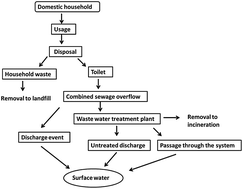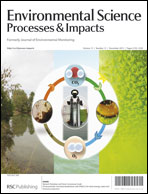Do natural rubber latex condoms pose a risk to aquatic systems?†
Abstract
The presence and potential adverse effects of plastic-polymers in the environment are receiving increasing attention in the popular and scientific press. However, quantifying emissions, exposure and effects of these materials remains a challenge. This paper describes the application of a questionnaire survey to quantify emissions of condom material from the domestic household to the sewage waste stream. Condoms are an important mainstay for birth control and the reduction of sexually transmitted infections. Survey participants were estimated to flush condoms down the toilet 2.96% of the time, and emissions were calculated as 0.99 mg of condom material per person per day. Using information on screening efficiencies at sewage treatment plants, the questionnaire data was combined with a GIS-based water quality model (LF2000-WQX) to predicted environmental concentrations (PEC) in a UK river basin catchment. Annual average PECs of condom material were 0.08–0.2 μg L−1, under the model scenario used. To put these PECs into context, rubber latex condom material was degraded in outdoor microcosms. This resulted in the formation of a complex mixture of substances including chemical degradation products and particles in the nano range. The direct effects of the degradation mixture were investigated using two freshwater organisms with different life cycle traits, the water column crustacean Daphnia magna and the sediment-dwelling larval of Chironomus riparius. Ecotoxicity tests investigated both acute and chronic endpoints and were shown to exhibit no toxic effects. This precluded the derivation of a genuine no-effect concentration. Hence, the results suggest that limited risk to invertebrates is associated with latex condom degradation products to the organisms tested. Future studies should extend this risk framework to assess risks of condoms to other taxonomic groups as well as the risks of other polymer materials.


 Please wait while we load your content...
Please wait while we load your content...